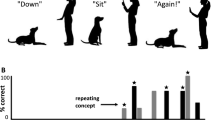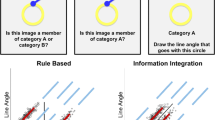Abstract
Concept identification performance was compared as a function of training on relevant (R), irrelevant (IR), or neutral (C) dimensions. The training was on either one or two dimensions and S made either a verbal and motor or just a motor response to each training stimulus. It was found that: (a) R training facilitates concept identification performance, (b) training on two dimensions facilitates performance irrespective of the relevance of the training dimensions, and (c) overt verbalization has no differential effect on performance in the transfer task.
Similar content being viewed by others
References
BROWN, F. G., & ARCHER, E. J. 1956. Concept identification as a function of task complexity and distribution of practice. J. exp. Psychol., 52, 316–321.
DUNCAN, D. B. 1955. Multiple range tests and multiple F tests. Biometrics, 11, 1–42.
DUNCAN, D. B. 1957. Multiple range tests for correlated and heteroscedastic means. Biometrics, 13, 164–176.
EDWARDS, A. E. 1960. Experimental design in psychological research. New York: Rinehart & Company, Inc.
GELFAND, S. 1958. Effects of prior associations and task complexity upon the identification of concepts. Psychol, Rep., 4, 567–574.
GOSS, A. E. 1961. Verbal mediating responses and concept formation. Psychol. Rev., 68, 248–274.
KENDLER, H. H., & KENDLER, T. S. 1962. Vertical and horizontal processes in problem solving. Psychol. Rev., 69, 1–16.
RASMUSSEN, E. A., & ARCHER, E. J. 1961. Concept identification as a function of language pretraining and task complexity. J. exp. Psychol., 61, 437–441.
TIGHE, L. S., & TIGHE, T. J. 1966. Discrimination learning: Two views in historical perspective. Psychol., Bull., 66, 353–370.
WOHLWILL, J. F. 1957. The abstraction and conceptualization of form, color, and number. J. exp. Psychol., 53, 304–309.
Author information
Authors and Affiliations
Additional information
This study is based on a dissertation submitted to the University of Wisconsin in partial fulfillment of the requirements for the Ph.D. degree. The advice of E. James Archer is gratefully acknowledged.
Rights and permissions
About this article
Cite this article
Namikas, G.A. The Effect of the Relevance and Number of Training Dimensions on Concept Identification Performance. Psychol Rec 18, 607–616 (1968). https://doi.org/10.1007/BF03393812
Published:
Issue Date:
DOI: https://doi.org/10.1007/BF03393812




